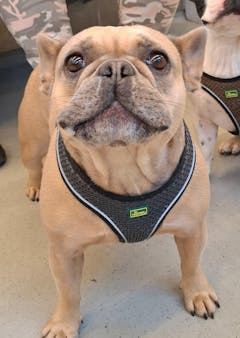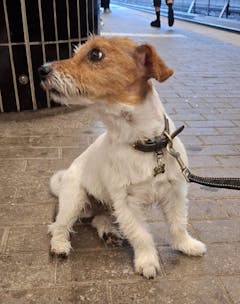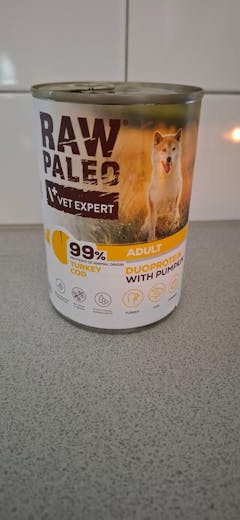Träningsleksaker
Hundprodukter > Hundleksaker > Träningsleksaker
Träningsleksaker: Ge Din Hund den Mentala Utmaning den Behöver
En hund är mer än bara en sällskapsdjur; de är intelligenta varelser som behöver både fysisk motion och mental stimulans för att må bra och vara balanserade. Medan traditionella **hundleksaker** som bollar och rep är utmärkta för fysisk aktivitet, är **träningsleksaker** designade för att utmana hundens intellekt, problemlösningsförmåga och naturliga instinkter. På Zoostar.se erbjuder vi ett brett och varierat sortiment av **träningsleksaker** som hjälper dig att utveckla din hunds kognitiva förmågor, förebygga tristess och bygga en starkare relation genom gemensam problemlösning. Att investera i **intelligensleksaker** är att investera i en gladare, lugnare och mer harmonisk hund.
Våra **träningsleksaker** spänner över allt från enkla **godisbollar** som får hunden att arbeta för sin belöning, till avancerade **pusselleksaker** med flera steg som kräver logiskt tänkande. De är perfekta för att kanalisera överskottsenergi, minska destruktivt beteende och för att ge din hund en meningsfull uppgift när den är ensam hemma. Oavsett ålder eller ras, finns det en **aktiveringsleksak** hos Zoostar.se som kan ge din hund den stimulans den förtjänar. Upptäck hur roligt och givande det kan vara att se din hund klura ut nya lösningar!
I den här guiden kommer vi att utforska varför **träningsleksaker** är så avgörande för din hunds välbefinnande, vilka olika typer som finns tillgängliga, och hur du väljer den bästa **intelligensleksaken** för din hund. Vi kommer också att dela med oss av tips för att introducera och använda dessa leksaker på bästa sätt för att maximera inlärning och nöje.
Varför Mental Stimulans är Nyckeln till en Balanserad Hund
Precis som människor behöver hundar mer än bara fysisk aktivitet för att trivas. Mental stimulans är avgörande för deras övergripande välmående och beteende:
1. Förebygger Tristess och Destruktivt Beteende:
- Uttråkade hundar: En hund som inte får tillräckligt med mental stimulans blir lätt uttråkad. Detta kan leda till oönskade beteenden som överdrivet skällande, tuggande på möbler, grävande eller att jaga sin egen svans.
- Kanaliserar energi: **Träningsleksaker** ger en sund utlopp för hundens mentala energi och håller den upptagen med en konstruktiv uppgift.
2. Förbättrar Kognitiva Förmågor:
- Problemlösning: **Intelligensleksaker** tvingar hunden att tänka, experimentera och lösa problem för att få en belöning (ofta godis). Detta stärker deras kognitiva funktioner och inlärningsförmåga.
- Koncentration: Leken med en **pusselleksak** kräver koncentration och uthållighet, vilket kan vara särskilt bra för hundar med svårt att fokusera.
3. Minskar Ångest och Stress:
När en hund är mentalt stimulerad och har en meningsfull uppgift, minskar det risken för ångest och stress. Att arbeta för sin mat eller godis kan också vara lugnande och ge en känsla av prestation.
4. Stärker Bandet Mellan Hund och Ägare:
Många **träningsleksaker** uppmuntrar till interaktion med ägaren. Att arbeta tillsammans för att lösa ett pussel eller lära sig nya kommandon med hjälp av en leksak, stärker förtroendet och kommunikationen.
5. Förbättrar Ätbeteende:
**Godisbollar** och foderautomater kan sakta ner hundar som äter för snabbt, vilket förbättrar matsmältningen och minskar risken för uppblåsthet.
Olika Typer av Träningsleksaker: Ett Urval för Varje Hund
På Zoostar.se hittar du ett brett spektrum av **träningsleksaker**, anpassade för olika svårighetsgrader och ändamål:
1. Godisbollar & Foderautomater:
- Syfte: Enkla **träningsleksaker** där hunden måste rulla, puffa eller skaka leksaken för att få ut godis eller foder.
- Fördelar: Perfekta för nybörjare, sakta ner ätandet, enkel mental stimulans.
- Exempel: Kong Wobbler, olika typer av rullande godisbollar.
2. Pusselleksaker / Intelligensleksaker:
- Syfte: Kräver mer avancerad problemlösning. Hunden måste flytta på luckor, lyfta block, dra i spakar eller vrida på delar för att komma åt godis.
- Fördelar: Hög mental stimulans, utmanar hundens logik och koordination. Finns i olika svårighetsgrader, från nybörjare till avancerade nivåer.
- Exempel: Nina Ottosson-leksaker är kända för sina innovativa pussel.
3. Snuffle Mats (Doftmattor):
- Syfte: Stimulerar hundens luktsinne och naturliga sökbeteende. Godis eller foder göms i tygflikar och veck på en matta, och hunden måste nosa sig fram till dem.
- Fördelar: Utmärkt för nosarbete, lugnande, minskar stress, bra för hundar som inte är lika motiverade av att "manövrera" leksaker.
4. Interaktiva kastleksaker med godis/foder:
- Syfte: Kombinerar fysisk aktivitet med belöning. Exempelvis en boll som kan fyllas med godis och släpper ut det vid rätt hantering.
- Fördelar: Motivationshöjande, perfekt för apportträning och belöning på distans.
- Exempel: Specifika apportblock med fack för godis.
5. Leksaker för utlärning av "släpp" och "håll":
- Syfte: Dessa leksaker används ofta i apporteringsträning eller för att lära hunden att inte bita sönder föremål. De kan vara i tåligt gummi eller syntetmaterial.
- Fördelar: Förbättrar lydnad, kontroll och samarbete.
Välja Rätt Träningsleksak för Din Hund
Att välja den **bästa träningsleksaken** kräver att du tar hänsyn till din hunds individuella egenskaper:
1. Svårighetsgrad:
- Börja enkelt: Om din hund är nybörjare på **intelligensleksaker**, börja med enklare varianter som **godisbollar** eller pussel på nivå 1.
- Öka gradvis: När hunden bemästrar en nivå, kan du introducera mer avancerade **pusselleksaker** för att hålla utmaningen vid liv.
2. Hundens Storlek och Ras:
Välj en **träningsleksak** som är anpassad för din hunds storlek. En för liten leksak kan utgöra en kvävningsrisk, och en för stor kan vara svår att hantera. Vissa raser, som Border Collies eller Poodles, är kända för sin intelligens och kan behöva mer avancerade utmaningar, medan andra raser kanske föredrar enklare **aktiveringsleksaker**.
3. Hundens Tuggstil:
Om din hund är en hård tuggare, se till att **träningsleksaken** är tillverkad av slitstarkt material som tål tugg. Många **pusselleksaker** är inte avsedda för hård tuggning och bör övervakas.
4. Material och Säkerhet:
Se till att leksakerna är tillverkade av giftfria material och att det inte finns några smådelar som kan lossna och sväljas. Kontrollera alltid leksakerna regelbundet för skador och byt ut dem om de är trasiga.
5. Motivationsfaktor:
Vissa hundar är mycket matmotiverade, vilket gör **godisbollar** och **pusselleksaker** med foder till ett utmärkt val. Andra hundar kanske motiveras mer av interaktion eller ljud, då kan leksaker som involverar aktiv lek med ägaren vara mer lämpliga.
Använda Träningsleksaker på Bästa Sätt
- Introducera gradvis: Visa hunden hur leksaken fungerar i början. Led dem genom stegen för att få ut godiset.
- Positiv förstärkning: Beröm alltid din hund när den lyckas! Det bygger självförtroende och uppmuntrar till fortsatt lek.
- Övervaka: Särskilt i början, övervaka leken för att säkerställa att hunden använder leksaken på rätt sätt och inte försöker tugga sönder den.
- Variera: Rotera **träningsleksakerna** för att hålla intresset vid liv. Introducera nya leksaker med jämna mellanrum.
- Korta sessioner: Speciellt för valpar eller hundar som lätt blir frustrerade, håll sessionerna korta och positiva.
- Lugn miljö: Använd **träningsleksaker** i en lugn och distraktionsfri miljö, åtminstone initialt, så hunden kan fokusera.
Träningsleksaker i Zoostars Totala Hundproduktsutbud
**Träningsleksaker** är en central och integrerad del av Zoostars breda sortiment av **hundprodukter**. De kompletterar andra leksakskategorier för att skapa en helhetslösning för din hunds behov:
- Hundleksaker: **Träningsleksaker** är en viktig underkategori inom vårt totala utbud av leksaker, fokuserade på kognitiv utveckling.
- Tuggleksaker: Vissa **tuggleksaker** kan också fungera som träningsleksaker, särskilt de som kan fyllas med godis för att hålla hunden sysselsatt.
- Mjukisleksaker: Även om de inte är primärt för träning, kan vissa mjukisleksaker användas i apportträning eller för att belöna lugnt beteende.
- Dentaleksaker: Vissa dentaleksaker har även inslag av pussel eller fack för godis, vilket ger både mental stimulans och munvård.
- Ljudleksaker: Kan användas i träningssammanhang för att locka till sig uppmärksamhet eller signalera belöning vid vissa övningar.
- Frisbeeleksaker & Bollar & Kastleksaker: Dessa används för fysisk träning, men även för att öva inkallning, apportering och impuls kontroll, som är viktiga delar av hundträning.
- Repleksaker: Utmärkta för att träna "släpp" och "hämta", samt för att bygga upp driv och lek.
- Vattenleksaker: Speciellt utformade för vattenbaserad träning som apport i sjö eller hav.
På Zoostar.se är vi stolta över att erbjuda ett brett utbud av **hundprodukter** som främjar en holistisk syn på din hunds välbefinnande. Våra **träningsleksaker** är ett bevis på vårt engagemang att hjälpa dig att ge din hund ett rikt, stimulerande och glädjefyllt liv. Utforska vårt sortiment idag och börja resan mot en smartare och lyckligare hund!
Vanliga Frågor om Träningsleksaker (FAQ)
Vad är en träningsleksak/intelligensleksak?
En **träningsleksak**, ofta kallad **intelligensleksak** eller **aktiveringsleksak**, är en typ av **hundleksak** som är designad för att stimulera hundens mentala förmågor snarare än bara fysisk aktivitet. De involverar ofta att hunden måste lösa ett problem, som att flytta på delar eller trycka på knappar, för att få tillgång till en belöning, oftast godis eller foder. De hjälper till att förebygga tristess, minska stress och förbättra hundens kognitiva färdigheter.
Passar träningsleksaker alla hundar?
Ja, **träningsleksaker** passar i princip alla hundar, oavsett ålder eller ras. Det viktigaste är att välja rätt svårighetsgrad och typ av leksak för just din hund. För **valpar** eller äldre hundar kan enklare **godisbollar** eller enklare **pusselleksaker** vara bäst. För mer intelligenta eller energiska raser kan mer avancerade **intelligensleksaker** vara nödvändiga för att ge tillräcklig utmaning. Det handlar om att hitta den leksak som engagerar din hund på rätt nivå.
Hur introducerar jag en träningsleksak för min hund?
Börja med att göra det enkelt för hunden. Visa hur leksaken fungerar genom att lägga godis synligt och enkelt att komma åt. Led hunden genom de första stegen. Beröm och belöna entusiastiskt när hunden lyckas, även om du hjälpte till. Öka svårighetsgraden gradvis först när hunden helt förstått den nuvarande nivån. Håll sessionerna korta och positiva, särskilt i början, för att undvika frustration.
Kan träningsleksaker ersätta promenader och fysisk aktivitet?
Nej, **träningsleksaker** är ett komplement till, inte en ersättning för, regelbundna promenader och fysisk aktivitet. En hund behöver både fysisk motion för att hålla sig frisk och stark, och mental stimulans för att vara balanserad. Tillsammans bidrar de till en hunds fulla välmående. En lång promenad tröttar kroppen, medan en **intelligensleksak** tröttar ut huvudet.
Hur ofta ska min hund leka med träningsleksaker?
Det beror på din hunds behov och energinivå. För många hundar kan 15-30 minuter med en **träningsleksak** om dagen vara tillräckligt för att ge god mental stimulans. Vissa hundar kan uppskatta flera kortare sessioner. Det är bra att rotera **träningsleksakerna** för att hålla intresset vid liv och erbjuda nya utmaningar. Att använda leksakerna för att utfodra delar av hundens måltider kan också vara ett utmärkt dagligt tillfälle för mental aktivering.
Hur rengör jag träningsleksaker?
De flesta **träningsleksaker** är lätta att rengöra. Gummi- och plastleksaker kan handdiskas med varmt vatten och mild tvål, eller i diskmaskinen om de är avsedda för det. Trä- eller laminerade pusselleksaker kan torkas av med en fuktig trasa. **Snuffle mats** kan ofta maskintvättas. Följ alltid tillverkarens instruktioner för rengöring för att säkerställa leksakens hållbarhet och hygien.
] }Husdjursprodukter Online
Utforska fler populära hundkategorier
Här hittar du många av våra mest efterfrågade kategorier – från hundfoder och godis till tillbehör, vård och aktivering.
Ledande Fodertillverkare
Populära hundfodermärken
Här hittar du våra mest populära hundfoder – från spannmålsfritt till veterinärfoder. Klicka på ett varumärke för att se hela sortimentet.






